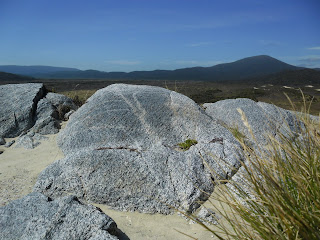This is a reconstruction of a soapstone karanga manu that was found on Rarotoka (Centre Island) in Foveaux Strait. The original is in Otago Museum (D31.760). I followed the same method of construction as the karanga manu I made on the first trip and used nails I found in the Homestead workshop for the relief carving. It's about 7cm long. Thanks to Rob Thorne for the use of his notes on this taoka.
The above instrument is a tōkere pipi. The pikao loops go over the fingers and the instrument is played much like a castenet. The pikao is from the Big Sandhill and the shells from Martin Creek. Im unsure if this was played in the South, but Ive always wanted to make some. There is a wooden example in Auckland Museum. They sound 'chattery', a bit like some of the Oyster Catchers around Mason Bay.
This is a pōrutu rākau tutu. It is cross blown from the far end and has three different tone centers. I split the wood, chiseled out the pitch and bound with some twine. It plays well.
I used the below hand/twist drill to drill the holes in the above porutu toroa. The drill stem is made from mānuka with pakohe/argellite drill points. Its takes about 4 mins to drill one wenewene hole in the toroa wing bone.
Paketekete was a bow and arrow remembered as being used as a toy by children in Riverton/Murihiku. It is possible the paketekete was also played as a mouth harp in a similar manner to the ku further north. This one is made from supple jack, fishing line, and toroa wing bone striker and toggle.
here is a link to some audio. I had a 'sound interaction' with some bellbirds with the above kōauau on the path to the beach.
I made this kōauau putiputi harakeke on my first trip...thought it was worth a mention. I poked out the inside with a metal rod I found in the Homestead workshop and burned out the inside a little to make it smooth and play well.
This barnicle was found on the beach at Masons and works well as a bird caller emitting quite high pitch sounds when played across the top.
This pūtōrino is made from rakau tutu, a larger woodier tutu. It plays very well. The word pūtōrino is used to describe a traditional instrument by southern sources in Beattie, but their description of the instrument varies with the northern pūtōrino which is what this example is modeled on.
The above kōauau is made from sea lion. Thanks to Mike Hilton for finding the bone for me.
I will post more soon!
Al



















